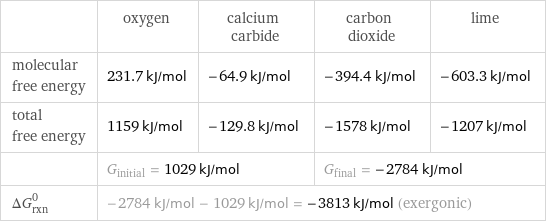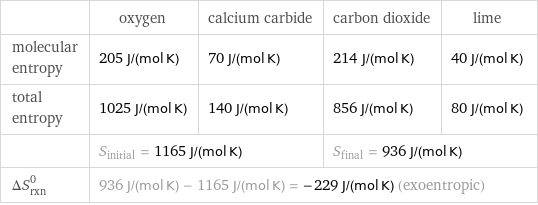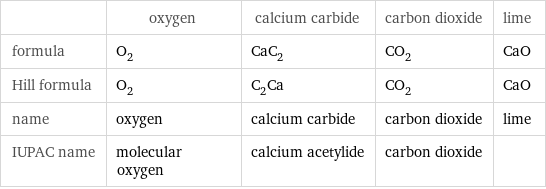Input interpretation

O_2 oxygen + CaC_2 calcium carbide ⟶ CO_2 carbon dioxide + CaO lime
Balanced equation

Balance the chemical equation algebraically: O_2 + CaC_2 ⟶ CO_2 + CaO Add stoichiometric coefficients, c_i, to the reactants and products: c_1 O_2 + c_2 CaC_2 ⟶ c_3 CO_2 + c_4 CaO Set the number of atoms in the reactants equal to the number of atoms in the products for O, C and Ca: O: | 2 c_1 = 2 c_3 + c_4 C: | 2 c_2 = c_3 Ca: | c_2 = c_4 Since the coefficients are relative quantities and underdetermined, choose a coefficient to set arbitrarily. To keep the coefficients small, the arbitrary value is ordinarily one. For instance, set c_2 = 1 and solve the system of equations for the remaining coefficients: c_1 = 5/2 c_2 = 1 c_3 = 2 c_4 = 1 Multiply by the least common denominator, 2, to eliminate fractional coefficients: c_1 = 5 c_2 = 2 c_3 = 4 c_4 = 2 Substitute the coefficients into the chemical reaction to obtain the balanced equation: Answer: | | 5 O_2 + 2 CaC_2 ⟶ 4 CO_2 + 2 CaO
Structures

+ ⟶ +
Names

oxygen + calcium carbide ⟶ carbon dioxide + lime
Reaction thermodynamics
Enthalpy

| oxygen | calcium carbide | carbon dioxide | lime molecular enthalpy | 0 kJ/mol | -59.8 kJ/mol | -393.5 kJ/mol | -634.9 kJ/mol total enthalpy | 0 kJ/mol | -119.6 kJ/mol | -1574 kJ/mol | -1270 kJ/mol | H_initial = -119.6 kJ/mol | | H_final = -2844 kJ/mol | ΔH_rxn^0 | -2844 kJ/mol - -119.6 kJ/mol = -2724 kJ/mol (exothermic) | | |
Gibbs free energy

| oxygen | calcium carbide | carbon dioxide | lime molecular free energy | 231.7 kJ/mol | -64.9 kJ/mol | -394.4 kJ/mol | -603.3 kJ/mol total free energy | 1159 kJ/mol | -129.8 kJ/mol | -1578 kJ/mol | -1207 kJ/mol | G_initial = 1029 kJ/mol | | G_final = -2784 kJ/mol | ΔG_rxn^0 | -2784 kJ/mol - 1029 kJ/mol = -3813 kJ/mol (exergonic) | | |
Entropy

| oxygen | calcium carbide | carbon dioxide | lime molecular entropy | 205 J/(mol K) | 70 J/(mol K) | 214 J/(mol K) | 40 J/(mol K) total entropy | 1025 J/(mol K) | 140 J/(mol K) | 856 J/(mol K) | 80 J/(mol K) | S_initial = 1165 J/(mol K) | | S_final = 936 J/(mol K) | ΔS_rxn^0 | 936 J/(mol K) - 1165 J/(mol K) = -229 J/(mol K) (exoentropic) | | |
Equilibrium constant
![Construct the equilibrium constant, K, expression for: O_2 + CaC_2 ⟶ CO_2 + CaO Plan: • Balance the chemical equation. • Determine the stoichiometric numbers. • Assemble the activity expression for each chemical species. • Use the activity expressions to build the equilibrium constant expression. Write the balanced chemical equation: 5 O_2 + 2 CaC_2 ⟶ 4 CO_2 + 2 CaO Assign stoichiometric numbers, ν_i, using the stoichiometric coefficients, c_i, from the balanced chemical equation in the following manner: ν_i = -c_i for reactants and ν_i = c_i for products: chemical species | c_i | ν_i O_2 | 5 | -5 CaC_2 | 2 | -2 CO_2 | 4 | 4 CaO | 2 | 2 Assemble the activity expressions accounting for the state of matter and ν_i: chemical species | c_i | ν_i | activity expression O_2 | 5 | -5 | ([O2])^(-5) CaC_2 | 2 | -2 | ([CaC2])^(-2) CO_2 | 4 | 4 | ([CO2])^4 CaO | 2 | 2 | ([CaO])^2 The equilibrium constant symbol in the concentration basis is: K_c Mulitply the activity expressions to arrive at the K_c expression: Answer: | | K_c = ([O2])^(-5) ([CaC2])^(-2) ([CO2])^4 ([CaO])^2 = (([CO2])^4 ([CaO])^2)/(([O2])^5 ([CaC2])^2)](../image_source/8bc9c5b31b8d22e9748fe9eb2503e80d.png)
Construct the equilibrium constant, K, expression for: O_2 + CaC_2 ⟶ CO_2 + CaO Plan: • Balance the chemical equation. • Determine the stoichiometric numbers. • Assemble the activity expression for each chemical species. • Use the activity expressions to build the equilibrium constant expression. Write the balanced chemical equation: 5 O_2 + 2 CaC_2 ⟶ 4 CO_2 + 2 CaO Assign stoichiometric numbers, ν_i, using the stoichiometric coefficients, c_i, from the balanced chemical equation in the following manner: ν_i = -c_i for reactants and ν_i = c_i for products: chemical species | c_i | ν_i O_2 | 5 | -5 CaC_2 | 2 | -2 CO_2 | 4 | 4 CaO | 2 | 2 Assemble the activity expressions accounting for the state of matter and ν_i: chemical species | c_i | ν_i | activity expression O_2 | 5 | -5 | ([O2])^(-5) CaC_2 | 2 | -2 | ([CaC2])^(-2) CO_2 | 4 | 4 | ([CO2])^4 CaO | 2 | 2 | ([CaO])^2 The equilibrium constant symbol in the concentration basis is: K_c Mulitply the activity expressions to arrive at the K_c expression: Answer: | | K_c = ([O2])^(-5) ([CaC2])^(-2) ([CO2])^4 ([CaO])^2 = (([CO2])^4 ([CaO])^2)/(([O2])^5 ([CaC2])^2)
Rate of reaction
![Construct the rate of reaction expression for: O_2 + CaC_2 ⟶ CO_2 + CaO Plan: • Balance the chemical equation. • Determine the stoichiometric numbers. • Assemble the rate term for each chemical species. • Write the rate of reaction expression. Write the balanced chemical equation: 5 O_2 + 2 CaC_2 ⟶ 4 CO_2 + 2 CaO Assign stoichiometric numbers, ν_i, using the stoichiometric coefficients, c_i, from the balanced chemical equation in the following manner: ν_i = -c_i for reactants and ν_i = c_i for products: chemical species | c_i | ν_i O_2 | 5 | -5 CaC_2 | 2 | -2 CO_2 | 4 | 4 CaO | 2 | 2 The rate term for each chemical species, B_i, is 1/ν_i(Δ[B_i])/(Δt) where [B_i] is the amount concentration and t is time: chemical species | c_i | ν_i | rate term O_2 | 5 | -5 | -1/5 (Δ[O2])/(Δt) CaC_2 | 2 | -2 | -1/2 (Δ[CaC2])/(Δt) CO_2 | 4 | 4 | 1/4 (Δ[CO2])/(Δt) CaO | 2 | 2 | 1/2 (Δ[CaO])/(Δt) (for infinitesimal rate of change, replace Δ with d) Set the rate terms equal to each other to arrive at the rate expression: Answer: | | rate = -1/5 (Δ[O2])/(Δt) = -1/2 (Δ[CaC2])/(Δt) = 1/4 (Δ[CO2])/(Δt) = 1/2 (Δ[CaO])/(Δt) (assuming constant volume and no accumulation of intermediates or side products)](../image_source/45e215a2dc6472b169cbf16d6205861a.png)
Construct the rate of reaction expression for: O_2 + CaC_2 ⟶ CO_2 + CaO Plan: • Balance the chemical equation. • Determine the stoichiometric numbers. • Assemble the rate term for each chemical species. • Write the rate of reaction expression. Write the balanced chemical equation: 5 O_2 + 2 CaC_2 ⟶ 4 CO_2 + 2 CaO Assign stoichiometric numbers, ν_i, using the stoichiometric coefficients, c_i, from the balanced chemical equation in the following manner: ν_i = -c_i for reactants and ν_i = c_i for products: chemical species | c_i | ν_i O_2 | 5 | -5 CaC_2 | 2 | -2 CO_2 | 4 | 4 CaO | 2 | 2 The rate term for each chemical species, B_i, is 1/ν_i(Δ[B_i])/(Δt) where [B_i] is the amount concentration and t is time: chemical species | c_i | ν_i | rate term O_2 | 5 | -5 | -1/5 (Δ[O2])/(Δt) CaC_2 | 2 | -2 | -1/2 (Δ[CaC2])/(Δt) CO_2 | 4 | 4 | 1/4 (Δ[CO2])/(Δt) CaO | 2 | 2 | 1/2 (Δ[CaO])/(Δt) (for infinitesimal rate of change, replace Δ with d) Set the rate terms equal to each other to arrive at the rate expression: Answer: | | rate = -1/5 (Δ[O2])/(Δt) = -1/2 (Δ[CaC2])/(Δt) = 1/4 (Δ[CO2])/(Δt) = 1/2 (Δ[CaO])/(Δt) (assuming constant volume and no accumulation of intermediates or side products)
Chemical names and formulas

| oxygen | calcium carbide | carbon dioxide | lime formula | O_2 | CaC_2 | CO_2 | CaO Hill formula | O_2 | C_2Ca | CO_2 | CaO name | oxygen | calcium carbide | carbon dioxide | lime IUPAC name | molecular oxygen | calcium acetylide | carbon dioxide |
Substance properties

| oxygen | calcium carbide | carbon dioxide | lime molar mass | 31.998 g/mol | 64.1 g/mol | 44.009 g/mol | 56.077 g/mol phase | gas (at STP) | solid (at STP) | gas (at STP) | solid (at STP) melting point | -218 °C | 2300 °C | -56.56 °C (at triple point) | 2580 °C boiling point | -183 °C | | -78.5 °C (at sublimation point) | 2850 °C density | 0.001429 g/cm^3 (at 0 °C) | 2.22 g/cm^3 | 0.00184212 g/cm^3 (at 20 °C) | 3.3 g/cm^3 solubility in water | | decomposes | | reacts surface tension | 0.01347 N/m | | | dynamic viscosity | 2.055×10^-5 Pa s (at 25 °C) | | 1.491×10^-5 Pa s (at 25 °C) | odor | odorless | | odorless |
Units
